Shell Plc Bundle
How is Shell plc Navigating the Energy Transition?
The energy sector is undergoing a seismic shift, and Shell plc is at the forefront of this transformation. Facing climate concerns and technological advancements, Shell's sales and marketing strategies are more critical than ever. This analysis explores how Shell is adapting its approach to remain competitive in the evolving energy market.
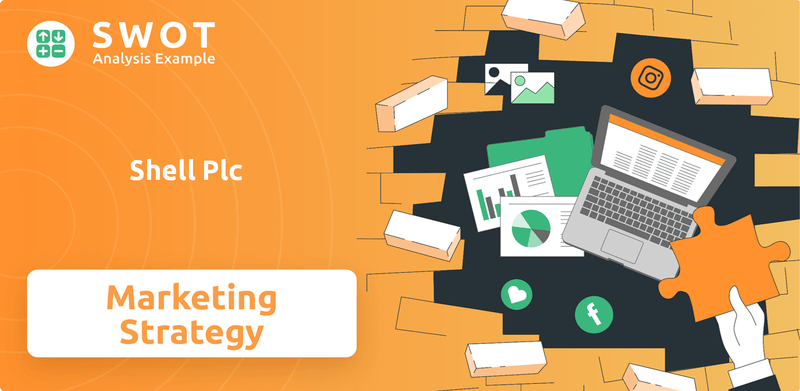
From its origins as an oil and gas giant, Shell has strategically pivoted towards renewable energy sources, significantly altering its Shell Plc SWOT Analysis and market perception. This shift impacts everything from its sales strategy to its marketing campaigns, requiring a deep understanding of its target audience demographics and a robust digital marketing presence. This document examines Shell's business model, competitive advantage, and how it positions its brand in a world increasingly focused on sustainability, offering actionable insights into Shell's sales and marketing approach.
How Does Shell Plc Reach Its Customers?
The sales channels of Shell Plc are designed to reach a diverse customer base across its Integrated Gas, Upstream, Chemicals and Products, and Renewables and Energy Solutions segments. These channels encompass both traditional and digital approaches, reflecting the company's commitment to adapting to changing market dynamics and customer preferences. The company's sales and marketing approach is multifaceted, ensuring broad market coverage and customer engagement.
Shell's physical retail locations, primarily its extensive network of service stations, remain a key sales channel. These stations serve as direct points of sale for fuels, lubricants, and convenience items to individual consumers and businesses. Furthermore, Shell utilizes direct sales teams and wholesale distributors for its business-to-business (B2B) segments, supplying products to industrial clients, aviation, and marine sectors. The company's strategy includes strategic partnerships and exclusive distribution deals to enhance market share.
In recent years, Shell has increased its digital adoption, especially in its Renewables and Energy Solutions segment. This includes online platforms for selling renewable electricity, smart energy solutions, and electric vehicle charging subscriptions. This shift towards digital channels and omnichannel integration reflects a broader industry trend and Shell's commitment to meeting customers where they are, whether at a physical station or through a digital interface. The performance of these channels varies, with traditional retail points maintaining high transaction volumes, while digital channels are increasingly critical for growth in emerging energy markets and for fostering direct customer relationships.
Shell operates a vast network of service stations globally, serving as a primary sales channel for fuels, lubricants, and convenience goods. These stations are crucial for direct customer interactions and maintaining brand visibility. In 2023, Shell's global retail network comprised approximately 46,000 service stations.
For its B2B operations, Shell relies on direct sales teams and wholesale distributors to supply products to industrial clients. This channel is vital for large-volume transactions and customized solutions. Shell's B2B sales contribute significantly to its overall revenue, with a focus on long-term contracts and strategic partnerships.
Shell is expanding its digital presence, particularly in the Renewables and Energy Solutions segment, to meet evolving customer needs. Online platforms offer renewable energy solutions and EV charging subscriptions. Digital channels are increasingly important for customer acquisition and engagement.
Shell forms strategic partnerships and distribution agreements to enhance market reach and customer access. These collaborations help secure market share in specialized segments. Partnerships with automotive manufacturers and logistics companies are examples of this strategy.
Shell's sales strategies are focused on maximizing market reach and customer engagement through a mix of traditional and digital channels. The company's approach involves adapting to changing market dynamics and customer preferences, ensuring a sustainable sales performance.
- Retail Network Optimization: Continuously improving service station offerings to include EV charging and expanded retail options.
- B2B Digital Integration: Enhancing online portals for order management and customer support to streamline B2B operations.
- Renewable Energy Sales: Expanding digital platforms for renewable energy solutions to meet growing demand.
- Strategic Partnerships: Forming alliances with key players in various sectors to strengthen market presence.
Shell Plc SWOT Analysis
- Complete SWOT Breakdown
- Fully Customizable
- Editable in Excel & Word
- Professional Formatting
- Investor-Ready Format
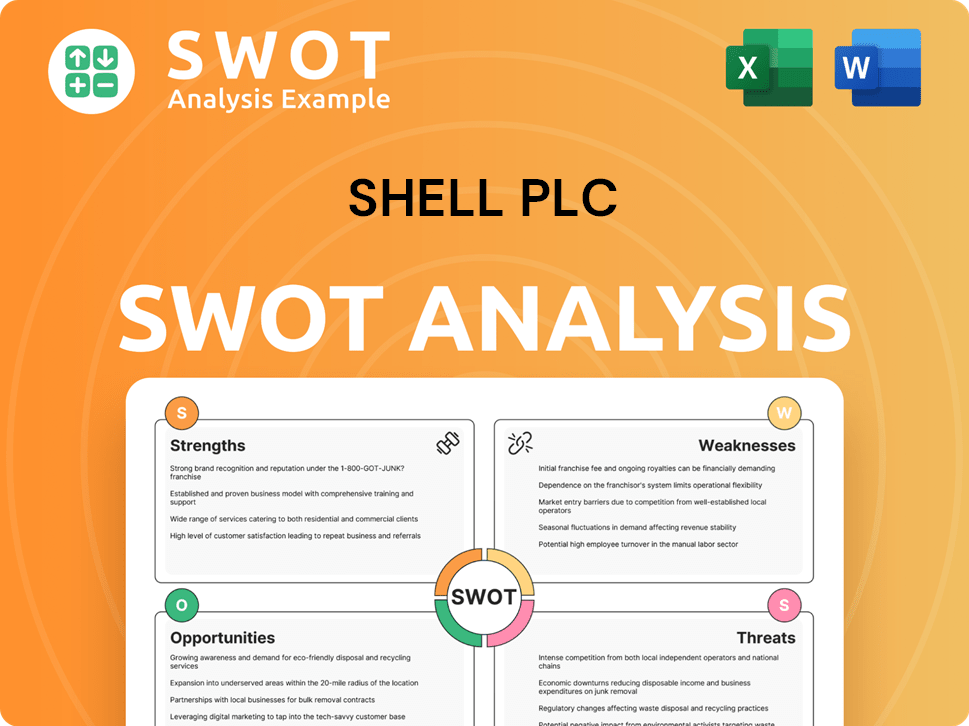
What Marketing Tactics Does Shell Plc Use?
The marketing tactics employed by Shell Plc are multifaceted, encompassing both digital and traditional strategies to boost brand awareness, generate leads, and drive sales across its varied business sectors. This comprehensive approach allows the company to reach a broad audience while also targeting specific customer segments effectively. Shell's marketing efforts are designed to reflect its evolving role in the energy market, emphasizing sustainability and innovation.
In the digital sphere, Shell leverages content marketing, SEO, and paid advertising across search engines and social media platforms. These initiatives are crucial for promoting fuel efficiency, electric vehicle charging, and renewable energy solutions. Traditional methods like TV, radio, and print media continue to play a role, particularly for retail fuel. Sponsorships of major events further enhance brand visibility.
Data-driven marketing is a key component, utilizing customer behavior data from loyalty programs and digital interactions to personalize marketing messages and optimize campaign performance. The company's marketing mix has evolved to highlight its role in the energy transition, aiming to appeal to environmentally conscious consumers and businesses. This shift reflects Shell's broader strategic goals in the Owners & Shareholders of Shell Plc.
Shell utilizes content marketing through its website and microsites to provide information on its energy transition strategy and product innovations. SEO is critical for visibility related to fuel efficiency and renewable energy. Paid advertising targets specific customer segments on various digital platforms.
Platforms like LinkedIn, X, and Facebook are used for corporate communications, brand building, and engaging stakeholders on energy transition topics. This engagement helps to build brand awareness and interact with customers.
Shell continues to use TV, radio, and print media for broad brand awareness campaigns, especially for its retail fuel business. Sponsorships of major events and sports teams also play a role in enhancing brand visibility.
Shell analyzes customer behavior data from its loyalty programs (e.g., Shell Go+) and digital interactions to segment customers and personalize marketing messages. Analytics tools are used to track campaign performance and optimize spending.
Experiential marketing at events and retail stations offers more than just fuel, providing convenience and integrated energy solutions. This approach aims to create a more engaging customer experience.
The marketing mix has shifted from a primary focus on petroleum products to a more diversified approach that highlights its role in the energy transition. This shift aims to appeal to environmentally conscious consumers and businesses.
Shell's marketing strategy is designed to enhance its Shell sales strategy and Shell marketing strategy, focusing on a blend of digital and traditional methods. The strategy supports the company's broader objectives, including its Shell business model and Shell competitive advantage. The company also uses data-driven insights to refine its approach and improve customer engagement. Key elements include:
- Content marketing to educate consumers about the energy transition and new product offerings.
- SEO to ensure high visibility for relevant search terms, such as 'fuel efficiency' and 'electric vehicle charging'.
- Paid advertising campaigns across various digital platforms targeting specific customer segments.
- Social media engagement on platforms like LinkedIn, X (formerly Twitter), and Facebook to build brand awareness.
- Traditional advertising through TV, radio, and print media to reach a broad audience.
- Sponsorships of major events and sports teams to enhance brand visibility.
- Data analysis of customer behavior to personalize marketing messages and optimize campaign performance.
- Experiential marketing at events and retail stations to offer integrated energy solutions.
Shell Plc PESTLE Analysis
- Covers All 6 PESTLE Categories
- No Research Needed – Save Hours of Work
- Built by Experts, Trusted by Consultants
- Instant Download, Ready to Use
- 100% Editable, Fully Customizable
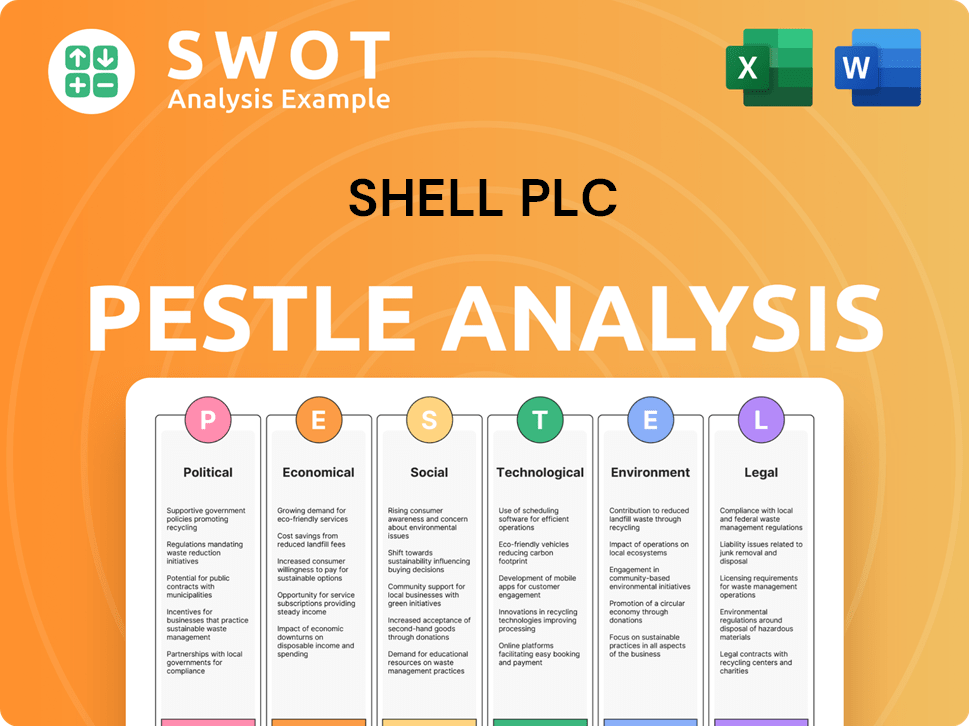
How Is Shell Plc Positioned in the Market?
The brand positioning of Shell plc centers on its role as a global energy leader, emphasizing its commitment to powering progress and driving the energy transition. This positioning is crucial for differentiating itself within the competitive Shell energy market, especially as the world shifts towards sustainable solutions. Shell's brand message is designed to resonate with a diverse audience, from individual consumers to large industrial clients and investors.
Shell's core narrative revolves around providing diverse energy solutions responsibly. This includes traditional fuels, biofuels, hydrogen, and renewable electricity. The company aims to balance its current operations with its future goals. The visual identity, anchored by the iconic scallop logo, maintains consistency across all platforms, conveying reliability and heritage. The tone of voice is authoritative and informative, while increasingly highlighting innovation and environmental stewardship.
The customer experience varies across different segments, from efficient service at retail stations to tailored solutions for industrial clients. This approach is key to maintaining a strong presence in the energy sector and adapting to changing consumer preferences. Shell's strategy involves transparently communicating its energy transition strategy and investing in relevant technologies. This proactive approach helps manage brand perception and address competitive threats.
Shell maintains a consistent brand identity globally, using its iconic scallop logo across all channels. This visual consistency reinforces brand recognition and trust. The company's communications emphasize reliability and heritage while increasingly focusing on innovation and sustainability.
Shell targets a broad audience, including environmentally conscious consumers, businesses seeking sustainable energy partners, and investors. Their marketing efforts are designed to appeal to these groups by highlighting the company's commitment to decarbonization and cleaner energy options. This approach supports Growth Strategy of Shell Plc.
Shell's communication strategy is authoritative and informative, with a growing emphasis on environmental stewardship. The company transparently communicates its energy transition strategy and investments in renewable technologies. This approach helps to manage brand perception and address competitive threats.
The customer experience varies by segment, from efficient service at retail stations to tailored solutions for industrial clients. This approach ensures that Shell meets the diverse needs of its customer base. This strategy supports Shell's Shell sales strategy.
Shell's brand positioning strategy hinges on key elements designed to resonate with its target audience and maintain a competitive edge in the energy market. These elements include a focus on sustainability, technological expertise, and consistent brand messaging.
- Sustainability Focus: Shell emphasizes its commitment to decarbonization and providing cleaner energy options, aligning with consumer demand for sustainable solutions. The company is investing heavily in renewable energy sources like wind and solar.
- Technological Expertise: Shell leverages its technological capabilities to develop innovative energy solutions, including advanced biofuels, hydrogen, and carbon capture technologies. This expertise is crucial for maintaining a competitive advantage.
- Consistent Brand Messaging: The company maintains a consistent brand identity across all channels, reinforcing brand recognition and trust. This consistency is vital for building a strong brand image.
- Global Presence: Shell's global operations allow it to serve diverse markets and adapt to regional energy demands. This broad presence supports its overall Shell marketing strategy.
- Adaptability: Shell actively responds to shifts in consumer sentiment, particularly regarding climate change and energy independence. This adaptability helps manage brand perception and address competitive threats.
Shell Plc Business Model Canvas
- Complete 9-Block Business Model Canvas
- Effortlessly Communicate Your Business Strategy
- Investor-Ready BMC Format
- 100% Editable and Customizable
- Clear and Structured Layout
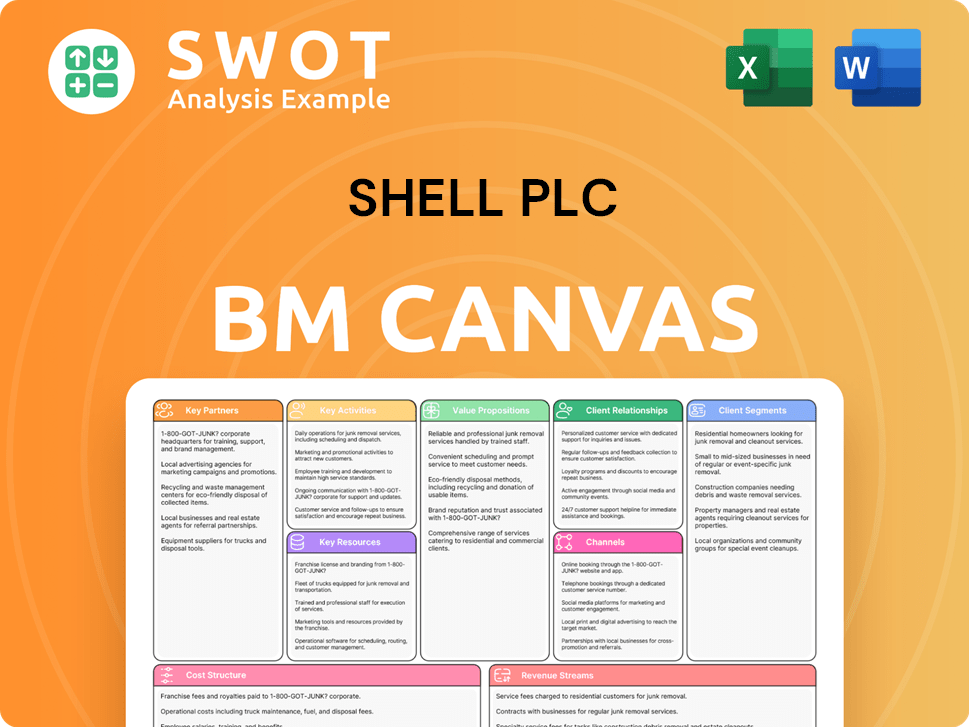
What Are Shell Plc’s Most Notable Campaigns?
Shell plc's sales and marketing strategies are undergoing a significant transformation, reflecting its strategic shift towards a more sustainable energy future. Key campaigns highlight this evolution, focusing on both corporate branding and specific product promotions. These initiatives aim to communicate Shell's commitment to the energy transition and drive customer adoption of new energy solutions.
The company's approach involves diverse marketing channels, including digital platforms, traditional advertising, and strategic partnerships. These campaigns are designed to enhance brand visibility, attract new customers, and engage with stakeholders. Through these efforts, Shell seeks to solidify its position in the evolving energy market and adapt to changing consumer preferences and environmental concerns.
Shell's sales strategy and marketing strategy are closely intertwined to support its business model. The company leverages these strategies to maintain a competitive advantage in the energy sector. For a comprehensive overview of Shell's business model and revenue streams, consider exploring Revenue Streams & Business Model of Shell Plc.
'Powering Progress' is a key marketing message and overarching corporate initiative. It aims to communicate Shell's strategy to accelerate the transition of its business to net-zero emissions. The campaign utilizes digital content, television commercials, and print advertisements to showcase Shell's actions.
These campaigns promote Shell's electric vehicle (EV) charging network, Shell Recharge. They aim to drive adoption of EV charging services and position Shell as a key player in future mobility. Digital advertising, in-app promotions, and partnerships with EV manufacturers are utilized.
Shell's marketing efforts are increasingly focused on sustainability, reflecting the growing importance of environmental considerations. This includes promoting renewable energy solutions and highlighting the company's investments in sustainable technologies. The goal is to improve public perception and attract environmentally conscious consumers.
Shell leverages digital marketing initiatives to reach a wider audience and engage with customers. This includes social media campaigns, targeted advertising, and content marketing strategies. Digital platforms are crucial for promoting new products and services.
Shell's sales performance indicators include several metrics used to evaluate the effectiveness of its marketing campaigns and overall sales strategies. These metrics are essential for tracking progress and making data-driven decisions. Key KPIs are:
- Increased utilization of charging points for Shell Recharge.
- Growth in app downloads and customer registrations for Shell Recharge.
- Enhanced brand visibility and positive media mentions for campaigns like 'Powering Progress'.
- Improved customer engagement on digital platforms.
- Market share in the renewable energy sector.
Shell Plc Porter's Five Forces Analysis
- Covers All 5 Competitive Forces in Detail
- Structured for Consultants, Students, and Founders
- 100% Editable in Microsoft Word & Excel
- Instant Digital Download – Use Immediately
- Compatible with Mac & PC – Fully Unlocked
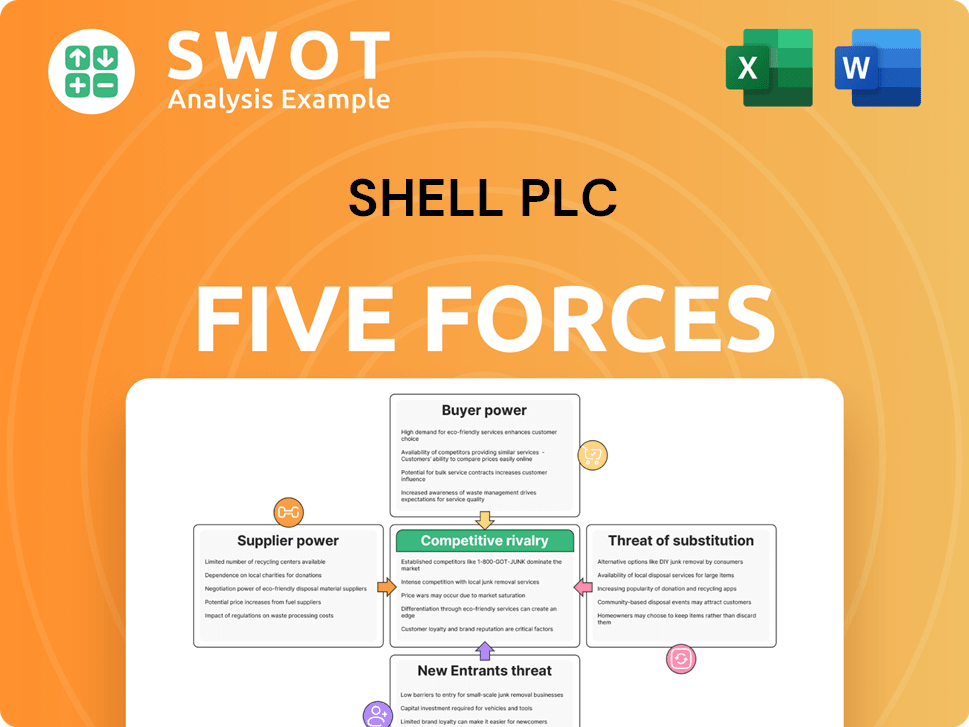
Related Blogs
- What are Mission Vision & Core Values of Shell Plc Company?
- What is Competitive Landscape of Shell Plc Company?
- What is Growth Strategy and Future Prospects of Shell Plc Company?
- How Does Shell Plc Company Work?
- What is Brief History of Shell Plc Company?
- Who Owns Shell Plc Company?
- What is Customer Demographics and Target Market of Shell Plc Company?
Disclaimer
All information, articles, and product details provided on this website are for general informational and educational purposes only. We do not claim any ownership over, nor do we intend to infringe upon, any trademarks, copyrights, logos, brand names, or other intellectual property mentioned or depicted on this site. Such intellectual property remains the property of its respective owners, and any references here are made solely for identification or informational purposes, without implying any affiliation, endorsement, or partnership.
We make no representations or warranties, express or implied, regarding the accuracy, completeness, or suitability of any content or products presented. Nothing on this website should be construed as legal, tax, investment, financial, medical, or other professional advice. In addition, no part of this site—including articles or product references—constitutes a solicitation, recommendation, endorsement, advertisement, or offer to buy or sell any securities, franchises, or other financial instruments, particularly in jurisdictions where such activity would be unlawful.
All content is of a general nature and may not address the specific circumstances of any individual or entity. It is not a substitute for professional advice or services. Any actions you take based on the information provided here are strictly at your own risk. You accept full responsibility for any decisions or outcomes arising from your use of this website and agree to release us from any liability in connection with your use of, or reliance upon, the content or products found herein.